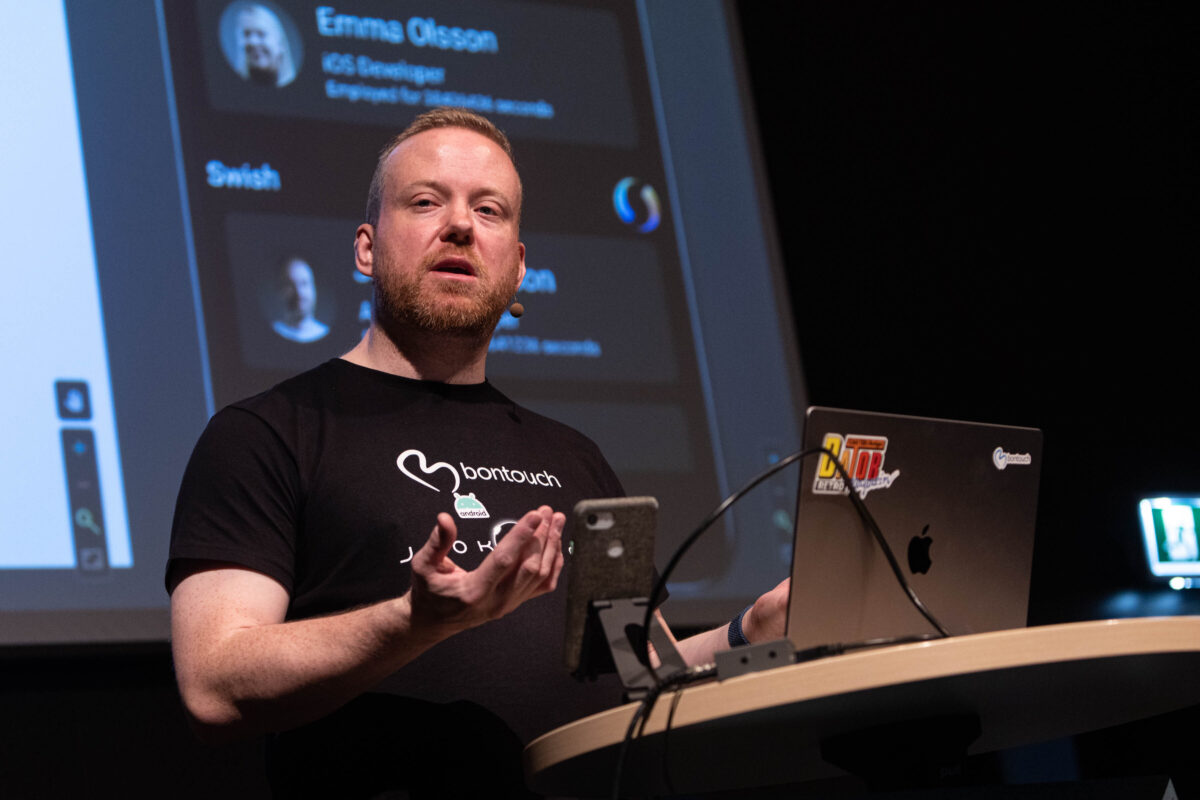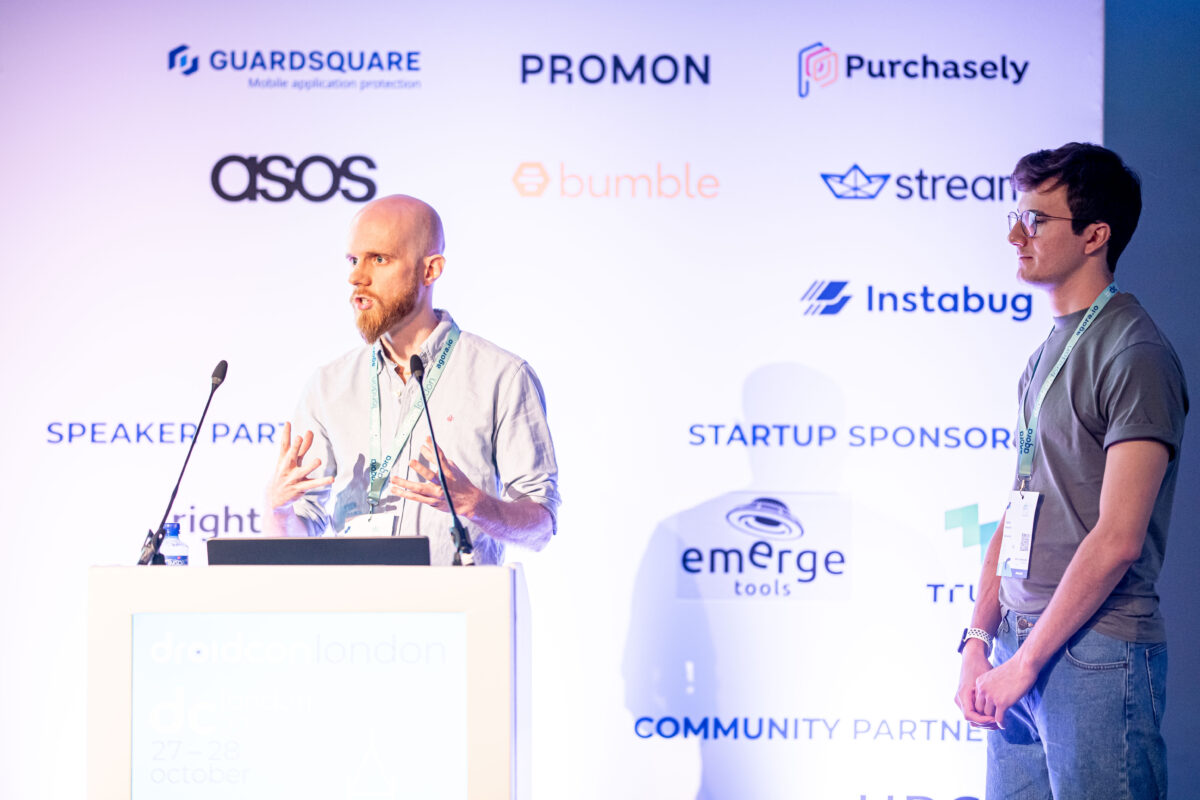
Lessons Learned: Our Experience Presenting at a Major Tech Conference for the First Time
Written by: Anders Järleberg (Lead Android Developer), Carlo Rapisarda (iOS Developer), Filip Trönnberg (Head of iOS), Robert Söderbjörn (Android Developer)
At Bontouch, we often share our knowledge with each other internally – in our project teams, within our competence areas, as well as generally within the company. One of the ways we do this is through presentations, where someone or a few people share their knowledge, experience, or learnings within an area.
In recent years, we have also started sharing more of our learnings externally – for example through this blog, and also by taking part in public events like meetups and conferences. Here are some of the talks we have presented at external conferences:
• Building a real-time collaboration tool using CRDTs and Kotlin Multiplatform
Anders Järleberg & Carlo Rapisarda
Droidcon, London, November 2022
• Declarative programming with Jetpack Compose – the future of Android UI development
Robert Söderbjörn
TechHeads, Kalmar, September 2022
• How to securely fetch cute cats from the Internet
Filip Trönnberg
TechHeads, Kalmar, September 2022
• Declarative programming – the future of Android UI development
Robert Söderbjörn
Northern Tech Talks, online, June 2022
• Building an Android UI using declarative programming in Jetpack Compose
Robert Söderbjörn
Jfokus, Stockholm, May 2022
For us, the authors of this blog post – Filip, Robert, Anders, and Carlo – this was the first time we were holding technical talks at major conferences, and we thought we’d share our experiences and learnings from this.
The process
Conferences will announce what’s called a call for papers (CFP) or call for speakers asking for people to submit their talks a number of months ahead of the conference. Usually, the CFP is open for several weeks, during which time people can make submissions. Typically, you’ll be asked for
• Title
• Duration
• An outline of the contents or the purpose of the talk
• Key takeaways and learnings that the audience are expected to get out of it
• Short biography of the people holding the talk
Make sure you prepare a good title, description, and key takeaways of your talk. You can of course deviate slightly in your talk from what you submit, but this information is critical for the conference organizers to select the appropriate talks to include. The more interesting and relevant your topic, the more likely your talk will be accepted. Our recommendation is that you have already started working on your presentation and have a good idea of what will be included in your talk by the time you submit it.
Note that it may be easier to get accepted to host a lightning talk rather than a full session, which can also be a lower-stakes way to get into public speaking. Also, having another speaker with you can help to provide support and divide the work.

Creating the presentation
The presentation itself, and the process of creating it, is the most important part and where you will spend most of your time. The best advice is to start early. Be prepared to spend a few hours a week several months before the conference. This will get you started and thinking about the best ways to present your content. Having recurring sessions to work on it gives you space and time in between to come up with ideas for improvements. However, the closer you get to the presentation, the more you’ll find to do – especially when it comes to perfecting the slides.
Tell a compelling story
You need to thoroughly think through the structure of your notes. They should ideally tell a cohesive and engaging story, almost like a book or a movie, building up anticipation and ending with a solid conclusion or learnings. The beginning and end are the most important!
Use humor to your advantage
Don’t take yourself too seriously. If you can include something that makes people laugh – an anecdote, funny reference, or even a slightly silly photo – you will have an easier time retaining the attention of the audience.
Run your presentation for other people
When you present to other people, you will find parts that don’t flow so well, feel superfluous, or need more explanation. It will allow you to time yourself as well as practice the presentation. You should, of course, also ask people for feedback to improve your presentation and your technique. Run it for colleagues, friends, and family. It can be useful to run it for smaller groups and use different people each time so you get fresh perspectives since your actual audience will be hearing it for the first time too.
Don’t be afraid to cut parts and focus on the essentials
The phrase “kill your darlings” applies here too. Sometimes you might have spent a lot of effort on a section or a slide but it might turn out to be superfluous or need to be reworked. The earlier you notice this, the better. Things can be more impactful if you don’t lose your audience in the details.
Slides
There are many other sources for tips and recommendations regarding good slides, but here are some things we tried to think about and some recommendations:
Show, don’t tell
In general, try to keep the amount of text on your slides to a minimum. Sometimes it can be hard to avoid – especially if you are showing code – but the more text you have, the fewer people will listen to you (because they are busy reading the text on the slides, whether they “want” to or not). If you are e.g. explaining how an algorithm works, just show the high-level steps and then explain each step in words (or split it over multiple slides). Better yet, if you can express your thoughts as a diagram, illustration, or animation on your slides, that could help enhance your explanation.
If you use bullet points, keep them short and only use a handful at a time, or it might feel overwhelming.
Make proper use of photo resources
You don’t have to use photos, but sometimes it can be a welcome distraction from text. Needless to say, if you do use them, make sure the copyright allows for it, and give proper credit. For example, you can find free photos from Unsplash or purchase them from sites like Shutterstock.
Be careful with animations
You can certainly use animations, especially to explain a complex subject, but don’t overuse them as a means to transition between slides since it can get distracting. If you do use them, make them discreet and intentional, and make their use consistent throughout the structure of your presentation – for example, having the same type of transition between different sections.
Make your slides functional first, then make them pretty
You’re probably familiar with the term bikeshedding – don’t spend your time deciding on the perfect color of something until you know what should go on the slide, and whether it is needed and useful.
Use consistent design
When you are satisfied with your content, by all means, spend some time and effort making the slides look good as well. Don’t use eye-grabbing fonts or colors that detract from your content, and use a text size that will be legible from a distance. Make sure your design is consistent, and if you have access to friends or colleagues with an eye for colors, shapes, and design – use them! Think about contrast – be careful with thin fonts or gray color, both of which could cause readability issues with projectors.

Before the conference
• Check with the organizers how you will hook up your computer to the projector. Make sure to bring any adapters that might be needed, even if the venue promises to provide them.
• Charge your laptop’s battery beforehand.
• Ensure you have backup copies of the presentation available – locally on your machine, in the cloud, and/or on a coworker/friend’s computer. You might even print the slides on paper as a final resort.
• If you are live coding, have a local file or repository prepared with working code if needed.
• If you are doing a live demo, consider having a pre-recorded video for backup.
• If you are showing live coding, remember that it might be difficult for the audience to read small text – more than a few presenters have made this mistake. Make sure you are familiar with your development environment’s presentation mode, which will use bigger fonts and strip away any unneeded user interface controls.
At the conference
There will typically be a speaker room for the speakers to prepare their presentations in quiet. The room will typically also have comfy chairs and refreshments – just watch your caffeine intake! 😉 Some things you may want to think about ahead of your talk:
• Consider emptying your pockets completely so that things like keys won’t cause unwelcome noise.
• Put away your phone and either shut it off completely or at least disable notifications.
• Also, turn off notifications on your laptop and any other devices.
• Test the Wi-Fi if you will need it in your presentation, or prepare a mobile hotspot.
Holding the presentation
It is completely normal to feel nervous as the time to present approaches. You’ll think about everything that can go wrong. It’s important to not panic, though, and accept that it is okay to have these feelings. Remember that you are an expert on the specific topic you’re presenting and that other speakers are human beings just like you. Take a deep breath, and don’t overthink.
Consider the talks you’ve seen from other speakers. Even the most confident-seeming speaker you’ve seen is going to be somewhat nervous when they start their talk, but you didn’t notice.
Once you’re up there and speaking for a while, getting into the rhythm of things, the nervousness will likely subside as well. If you practiced your slides well, you will exude confidence and competence, and you’ll find it both fun and rewarding despite your initial uncertainty.
Of course, there can be small hiccups or even major issues, whether due to technical issues, mistakes, etc. First of all, don’t panic. If it’s a small issue you don’t even need to call attention to it, people won’t have noticed. In the case of larger issues, like a live demo crashing, a video not playing, etc, simply apologize and try your best to resolve it. If you are well-prepared, you will likely have a fallback available. People understand that these things happen and it doesn’t reflect poorly on you.
You’ll probably find that holding a presentation at a conference is not much different from presentations you’ve done in front of other people before. Sure, the people you’re presenting to are strangers and maybe the audience is larger than you’re used to, but the process is identical for you. You’ve done this before! ⭐

Practical tips
Here are some tips based on our experiences that you might think about to give the best presentation possible.
Time yourself
When you are nervous and presenting for the first time, it’s easy to speed up and speak quickly — perhaps in a subconscious effort to “get it over with quickly”. This can make it harder for people to follow along and your talk might end up shorter than intended.
You will be expected to keep to the conference schedule, so if you don’t end up covering all of your content in the time allotted, you’ll have to end it as best as you can. Therefore it’s a very good idea to time yourself every time you practice your talk – try to time how long you spend in each major section to identify what parts are the longest and to provide checkpoints during your talk. For example, you can mark that you expect to be starting the second section eight minutes into the talk in your speaker notes, which gives you a reference time when you reach that section. There is also dedicated software specifically to help with staying on schedule, e.g. Agenda Defender.
Know your slides, forwards and backwards
Be aware of what slides you have, what’s explained on them, what animations are happening (i.e. when and how many times to hit next slide while presenting), etc. You should also be prepared to be able to go back in case you accidentally skip ahead, you forgot something, or there is a question about a prior slide. It then helps to know where you are in your slides and what’s behind and what’s coming up. Study your slides and try it in practice. This also includes planning ahead for things like technical issues and fallbacks.
Consider using a clicker
When you’re on stage, you may find it more natural (and the audience may find it more engaging) if you’re moving around while speaking instead of being glued to the computer. This means you’d need a clicker to change slides and a lavalier/lapel mic or handheld mic – the conference venue can probably accommodate. Make sure you practice this and feel comfortable with it, if so.
Audience questions
You can opt to leave room at the end and take questions from the audience. You don’t have to, of course – you can also ask people to come by and ask you in person after, which you may feel more comfortable with. If you do take questions from the audience, don’t worry about feeling like you have to be an expert or able to answer every question. It’s fine to be honest if you don’t know the answer. Also, if the person posing the question doesn’t get a microphone, repeat their question first for the benefit of the audience in the back – this also gives you a little time to think about your response.
Conclusion
Based on our experiences, hosting a conference talk is not as big of a deal as you might think beforehand. You should of course expect to spend quite a bit of time on the preparations, but having done this, the actual talk itself will be fun and feel like a breeze! You’ll be able to walk around at the conference afterward and people might come up to you mentioning your talk or ask questions about the topic, which can be a nice icebreaker and a good way to find new contacts in the industry. Additionally, your professional brand – as well as that of your company – gets a boost in connection with the conference and your experience goes nicely on a CV. 😄